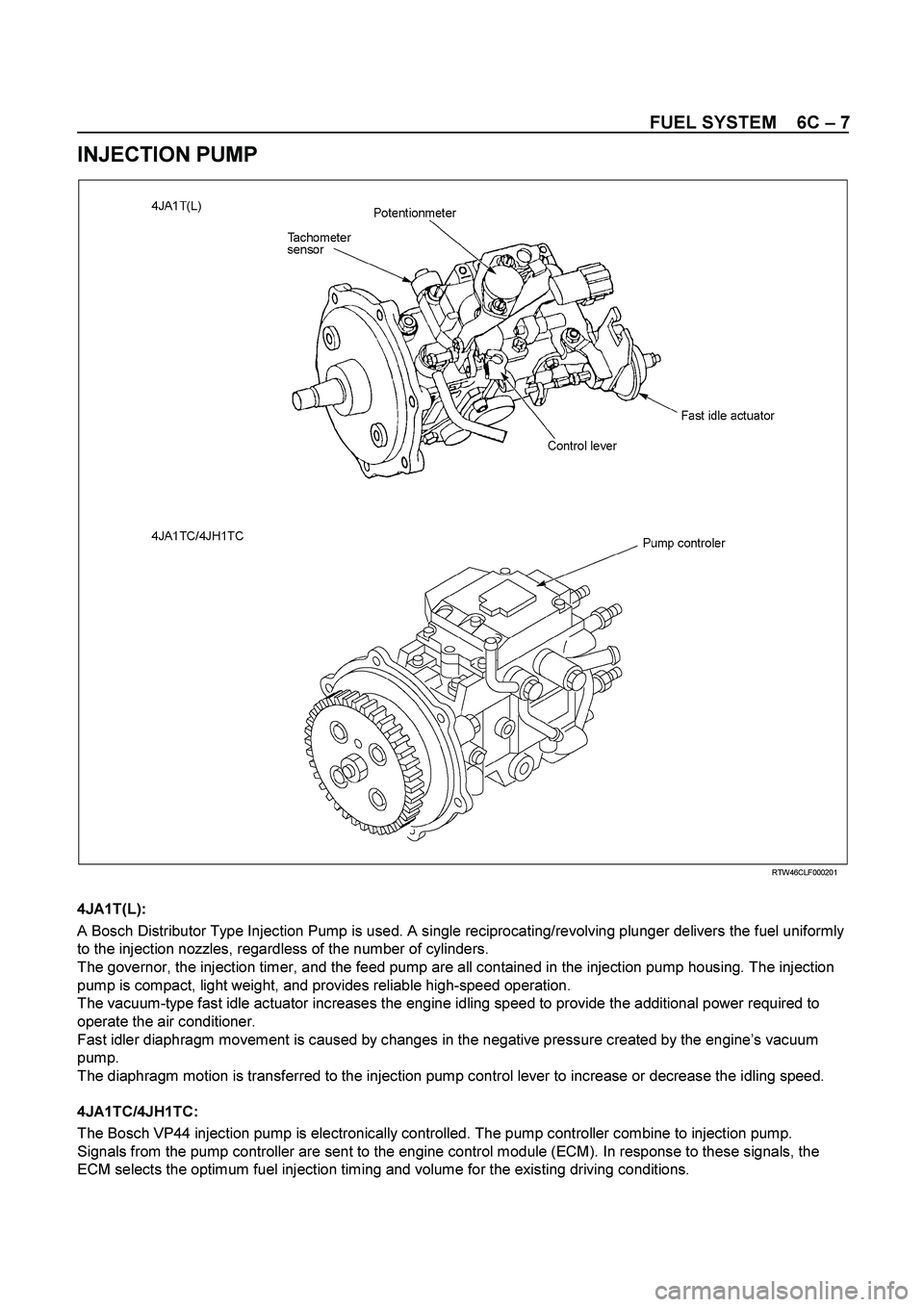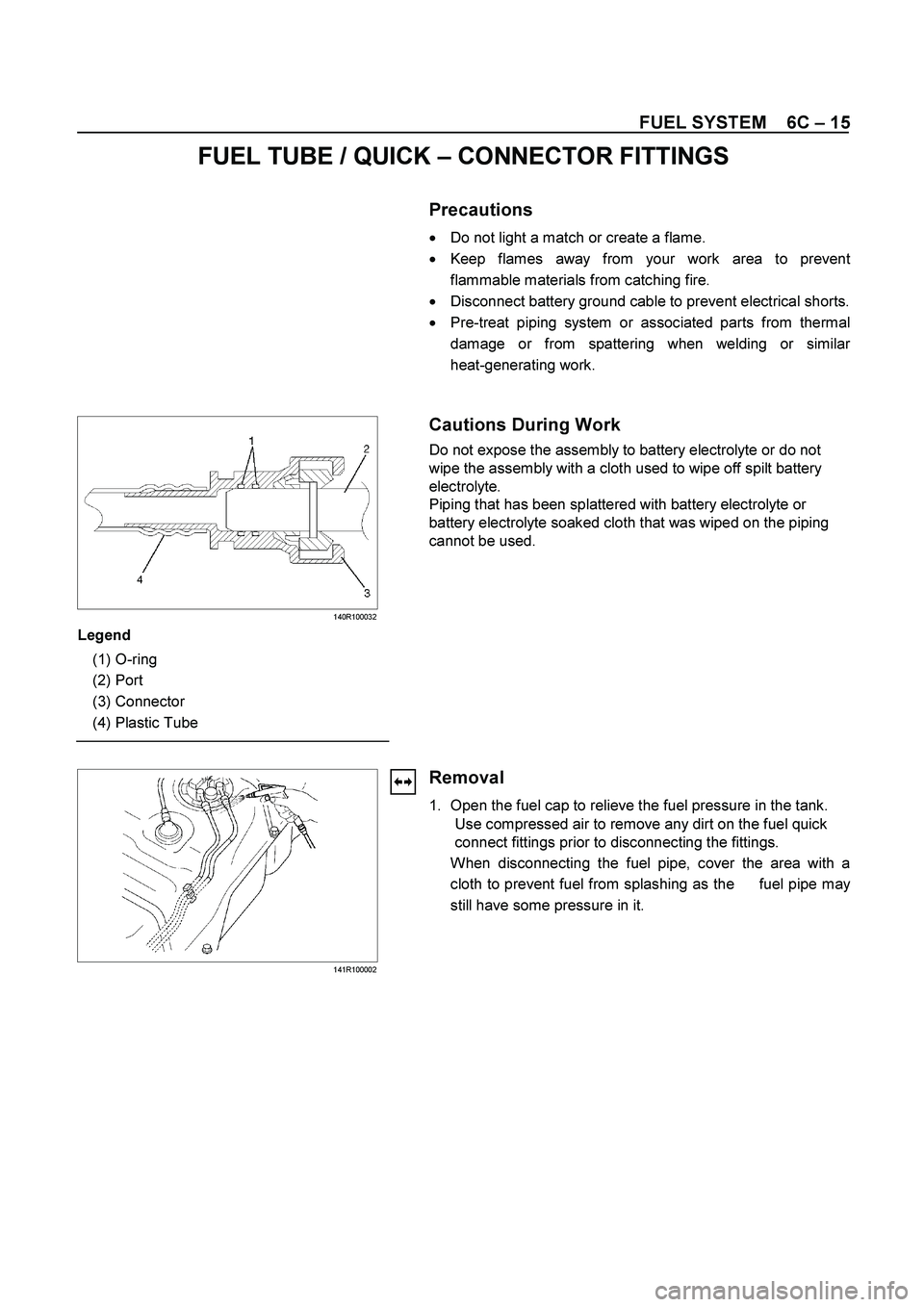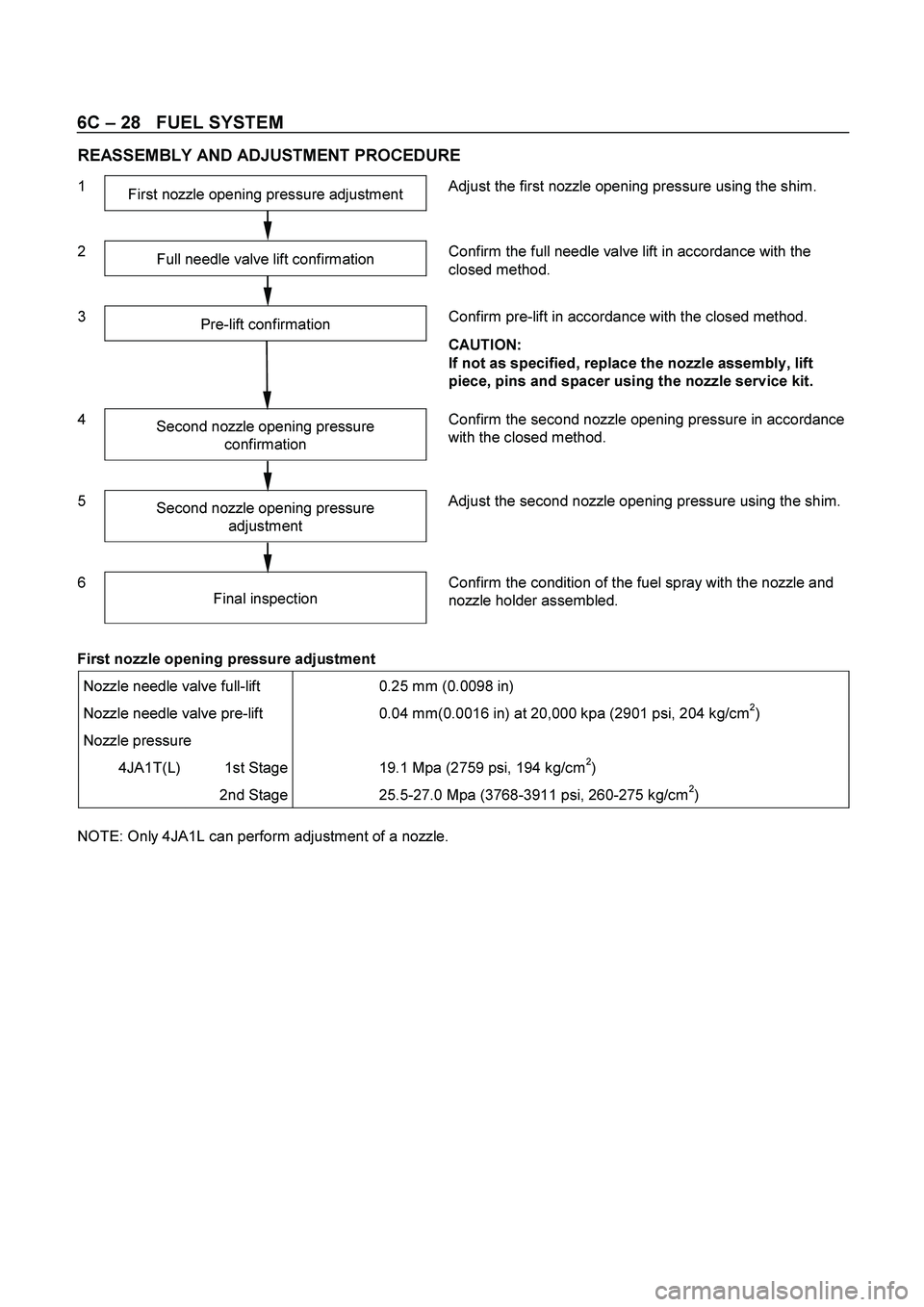Page 1307 of 4264

FUEL SYSTEM 6C – 7
INJECTION PUMP
RTW46CLF000201
4JA1T(L):
A Bosch Distributor Type Injection Pump is used. A single reciprocating/revolving plunger delivers the fuel uniformly
to the injection nozzles, regardless of the number of cylinders.
The governor, the injection timer, and the feed pump are all contained in the injection pump housing. The injection
pump is compact, light weight, and provides reliable high-speed operation.
The vacuum-type fast idle actuator increases the engine idling speed to provide the additional power required to
operate the air conditioner.
Fast idler diaphragm movement is caused by changes in the negative pressure created by the engine’s vacuum
pump.
The diaphragm motion is transferred to the injection pump control lever to increase or decrease the idling speed.
4JA1TC/4JH1TC:
The Bosch VP44 injection pump is electronically controlled. The pump controller combine to injection pump.
Signals from the pump controller are sent to the engine control module (ECM). In response to these signals, the
ECM selects the optimum fuel injection timing and volume for the existing driving conditions.
Page 1310 of 4264

6C – 10 FUEL SYSTEM
Removal
CAUTION: When repair to the fuel system has been
completed, start engine and check the fuel system for
loose connection or leakage. For the fuel system
diagnosis, see Section “Driveability and Emission".
1. Disconnect battery ground cable.
2. Loosen slowly the fuel filler cap.
NOTE: Be careful not to spouting out fuel because of change
the pressure in the fuel tank.
NOTE: Cover opening of the filler neck to prevent any dus
t
entering.
3. Jack up the vehicle.
4. Support underneath of the fuel tank with a lifter.
5. Remove the inner liner of the wheel house at rear left side.
6. Remove fixing bolt of the filler neck from the body.
7.
Disconnect the quick connector (3) of the fuel tube from the
fuel pipe.
NOTE: Cover the quick connector to prevent any dust entering
and fuel leakage.
NOTE: Refer to“Fuel Tube/Quick Connector Fittings” in this
section when performing any repairs.
8. Remove fixing bolt (1) of the tank band and remove the
tank band (2).
9.
Disconnect the pump and sender connector on the fuel
pump and remove the harness from weld clip on the fuel
tank.
10.
Lower the fuel tank (5).
NOTE: When lower the fuel tank from the vehicle, don’t scratch
each hose and tube by around other parts.
Installation
1. Raise the fuel tank.
NOTE: When raise the fuel tank to the vehicle, don’t scratch
each hose and tube by around other parts.
2. Connect the pump and sender connector to the fuel pump
and install the harness to weld clip on the tank.
NOTE: The connector must be certainly connected agains
t
stopper.
3. Install the tank band and fasten bolt.
Torque N·m (kg·m / lb ft)
68 (6.9 / 50)
NOTE: The anchor of the tank band must be certainly installed
to guide hole on frame.
4. Connect the quick connector of the fuel tube to the fuel pipe
and the evapo tube from evapo joint connector.
NOTE: Pull off the left checker on the fuel pipe.
NOTE: Refer to “Fuel Tube/Quick Connector Fittings” in this
section when performing any repairs.
Page 1314 of 4264
6C – 14 FUEL SYSTEM
8.
Check leak.
Methed of leak check.
(1)
Plug end of quick connector and breather hose (Pull of
f
the breather hose from fuel tank) and tighten fuel fille
r
cap until at least one click are heard.
(2)
Apply water soap around the fuel gauge unit seal area.
(3)
Pressure air into the fuel tank from end of breather pipe
at 5psi (34.3 kPa/2.8kgf/cm
2) over 15 seconds.
(4)
Verify no bubbles around the fuel gauge unit seal area.
9.
Install the fuel tank assembly (9).
NOTE: Refer to “Install the fuel tank” in this section.
Page 1315 of 4264

FUEL SYSTEM 6C – 15
FUEL TUBE / QUICK – CONNECTOR FITTINGS
Precautions
�
Do not light a match or create a flame.
�
Keep flames away from your work area to preven
t
flammable materials from catching fire.
�
Disconnect battery ground cable to prevent electrical shorts.
�
Pre-treat piping system or associated parts from thermal
damage or from spattering when welding or simila
r
heat-generating work.
140R100032
Legend
(1)
O-ring
(2)
Port
(3)
Connector
(4)
Plastic Tube
Cautions During Work
Do not expose the assembly to battery electrolyte or do not
wipe the assembly with a cloth used to wipe off spilt battery
electrolyte.
Piping that has been splattered with battery electrolyte or
battery electrolyte soaked cloth that was wiped on the piping
cannot be used.
141R100002
Removal
1. Open the fuel cap to relieve the fuel pressure in the tank.
Use compressed air to remove any dirt on the fuel quick
connect fittings prior to disconnecting the fittings.
When disconnecting the fuel pipe, cover the area with a
cloth to prevent fuel from splashing as the fuel pipe ma
y
still have some pressure in it.
Page 1318 of 4264
6C – 18 FUEL SYSTEM
FUEL FILLER CAP
RTW36CSH000401
Legend
(1)
Pressure Valve
(2)
Vacuum Valve
(3)
Seal Ring
General Description
A vacuum valve and pressure valve are built into the fuel filler
cap which adjusts the fuel pressure in the fuel tank to prevent
fuel tank damage.
Inspection
The fuel filler cap must be inspected for seal condition.
The fuel filler cap must be replaced if found defective
CAUTION: A replacement fuel filler cap must be the same
as the original. The fuel filler cap valve was designed
primarily for this application and must be replaced with
the same type or decreased engine performance may
occur.
Page 1326 of 4264
6C – 26 FUEL SYSTEM
INJECTION NOZZLE (4JA1L)
DISASSEMBLY
080L200009
Disassembly Steps
1.
Retaining nut 9.
Collar
2.
Nozzle & pin 10.
Spring seat
3.
Spacer & pin 11.
First spring
4.
Lift Piece 12.
Shim (First nozzle opening
pressure adjustment)
5.
Spring seat 13.
Nozzle holder body
6.
Push rod 14.
Eye bolt
7.
Shim (Second nozzle opening
pressure adjustment) 15.
Gasket
8.
Second spring
Important Operations
Injection nozzle adjustment is possible only on the 4JA1L
engine.
The two-spring nozzle holder has been developed to
reduce NOx (Nitrogen Oxides) and particulates from direct
injection diesel engine exhaust.
Before disassembly remove carbon deposit from nozzle
and nozzle holder using a wire brush and wash the outside
nozzle holder assembly.
Caution:
Do not touch nozzle holes with the wire brush during
cleaning it.
Disassemble the nozzle holder assembly to numerical
order.
Page 1327 of 4264
FUEL SYSTEM 6C – 27
REASSEMBLY
080L200010
Reassembly Steps
1.
Nozzle holder body 9.
Spring seat
2.
Shim (First opening pressure
adjustment) 10.
Lift Piece
3.
First spring 11.
Spacer & pin
4.
Spring seat 12.
Nozzle & pin
5.
Collar 13.
Retaining nut
6.
Second spring 14.
Gasket
7.
Push rod 15.
Eye bolt
8.
Shim (Second opening pressure
adjustment)
Important Operations
The nozzle holder is adjusted as the components are
reassembled in the sequence above.
As adjustment of the two-spring nozzle holder is made in
hundredths of a millimeter, clean the parts thoroughly in
light oil to completely remove any dirt or foreign matter.
Page 1328 of 4264

6C – 28 FUEL SYSTEM
REASSEMBLY AND ADJUSTMENT PROCEDURE
1
First nozzle opening pressure adjustment Adjust the first nozzle opening pressure using the shim.
2
Full needle valve lift confirmation Confirm the full needle valve lift in accordance with the
closed method.
3
Pre-lift confirmation
Confirm pre-lift in accordance with the closed method.
CAUTION:
If not as specified, replace the nozzle assembly, lift
piece, pins and spacer using the nozzle service kit.
4
Second nozzle opening pressure
confirmation Confirm the second nozzle opening pressure in accordance
with the closed method.
5
Second nozzle opening pressure
adjustment Adjust the second nozzle opening pressure using the shim.
6
Final inspection Confirm the condition of the fuel spray with the nozzle and
nozzle holder assembled.
First nozzle opening pressure adjustment
Nozzle needle valve full-lift 0.25 mm (0.0098 in)
Nozzle needle valve pre-lift 0.04 mm(0.0016 in) at 20,000 kpa (2901 psi, 204 kg/cm2)
Nozzle pressure
4JA1T(L) 1st Stage 19.1 Mpa (2759 psi, 194 kg/cm2)
2nd Stage 25.5-27.0 Mpa (3768-3911 psi, 260-275 kg/cm2)
NOTE: Only 4JA1L can perform adjustment of a nozzle.